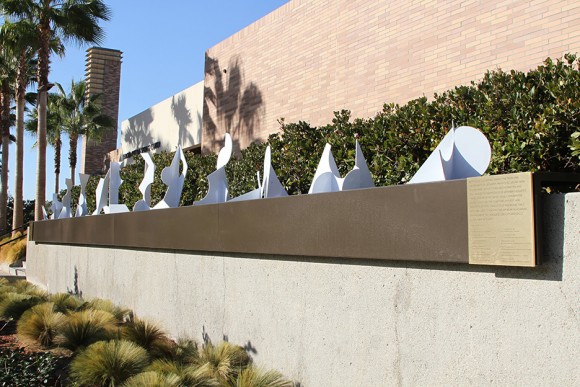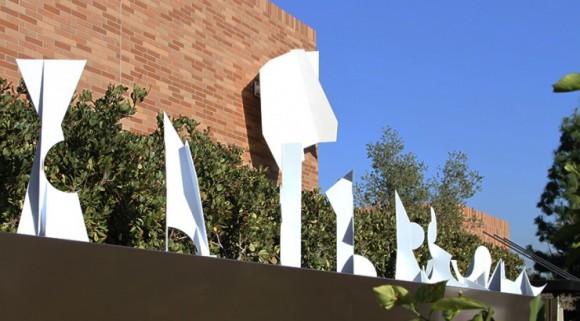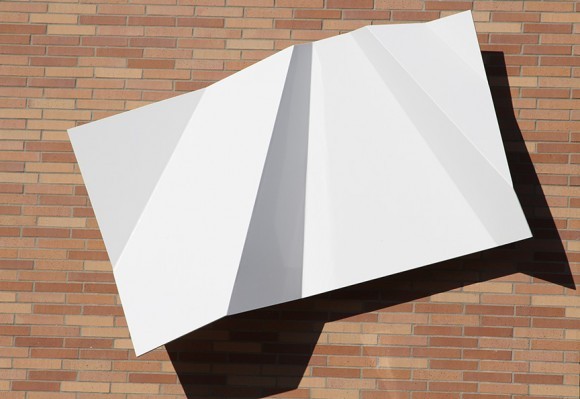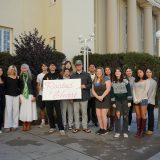
Solid Gold
January 11, 2016
Sculptor Betty Gold may work from basic geometric forms, but the end result of her pieces is nothing short of complex and multidimensional. Born in Austin, Texas and currently based in Venice, California, Gold has had a long and exciting career. At eighty years of age, she still creates work today. We are lucky to have a few of her works in our Escalette Collection here at Chapman. Most recently, we had three of her studies on display at Paths and Edges, the Escalette Collection’s five year anniversary show. Most Chapman students will likely recognize Colgado II, the white sculpture that hangs on the outside of the Hutton Sports Center. Gold’s work has a strong presence and is often hard to ignore!
Betty Gold’s journey to becoming an artist was not a straight path. She initially studied at University of Dallas with a major in elementary education. She was also involved in beauty pageants in her youth, even snagging the title of Miss Texas. Gold married, adopted a daughter, got divorced, then got remarried to a dress manufacturer. By modeling for her husband’s clothing line, she was able raise enough money to go back to school to take art history, painting and sculpture classes. After she was finished with school, Gold shared a studio with five other women, and aggressively created as much work as she could. At the age of 35, Gold had her first solo show. Since the 1970s, Gold has had her work in galleries, museums and permanent collections all around the world.
Although Gold began her career working with the human figure, she discovered quite early on that she much preferred working in geometric forms:
“With the exception of some photographic work, everything I have done for the major part of my career has been based on a geometric concept. It never becomes tiresome and I continue to find new ways in which to express its truth and universality. Every new project is like the first: challenging, fulfilling, and exciting.”
Though geometric structures can easily feel rigid, Gold manages to use geometry in a way that gives it plenty of personality. She is inspired by abstract sculptors that include a more playful element to their work, such as Pablo Picasso, Barbara Hepworth, and Alexander Calder. Gold’s geometric style may seem similar to minimalism, but there is something more organic and personal about Gold’s work. For this reason, Gold is often associated more with the MADI art movement.
Gold is constantly inspired by her surroundings and her travels. She fell in love with Mallorca, Spain and has created plenty of work reflect her love for the Spanish island. The titles of her work often communicate what she intends to express (for example, Colgado means “hanging” in Spanish). She was inspired to work in three dimensions when she observed two flat paintings leaning against each other in her studio. She loved how the brightly colored shapes balanced off each other, and began working in steel to bring her visions to life.
Unlike some conceptual artists, Gold is involved in every part of the process to create her large steel sculptures. First she folds paper to create a basic design. Then, she creates models from cardboard and glue and studies them from every angle. Finally, she cuts flat shapes of steel and assembles them into the final three dimensional product. Gold’s process defies gender stereotypes. In a sense, the industrial nature of cutting her own steel is a very masculine action. But Gold also sees a sense of femininity in how she creates her work – she compares the cutting of steel to when she used to sew her own clothes in her youth, and she still manages to approach her work with a delicate touch.
The result of Gold’s work is a collection of forms that speak their own language. Much of Gold’s work is best viewed outside, as the acute shadows they cast change throughout the day creating different interpretations. Through the heavy material, she is still able to create a sense of weightlessness and movement. There is a sense of order, but also a sense of disjointedness in the unique structures. Although Gold puts a lot of herself into her work, the viewer is also able to put themselves into the narrative and form their own readings.
Next time you see Betty Gold’s work on campus, take a moment to observe the captivating dance of her geometric sculptures!




